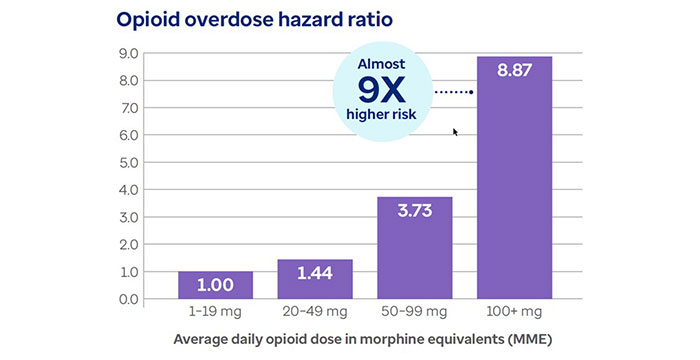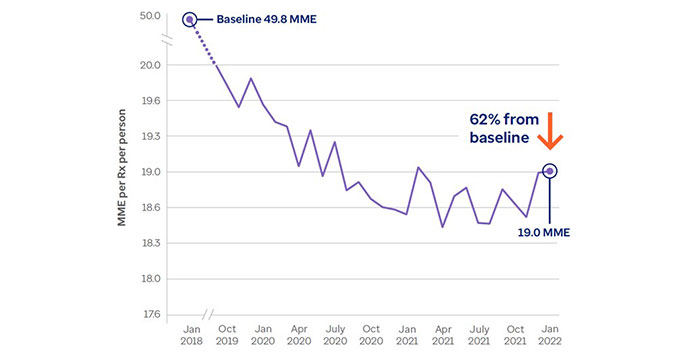Fighting the tide of opioid overdose
Recent headlines remind us that the COVID-19 pandemic has coincided with a dramatic spike in drug overdose deaths in the U.S.1,2
After remaining relatively flat between 2017 and 2018, overdose deaths jumped 32% in 2020 over 2019.3 According to the Centers for Disease Control and Prevention (CDC), overdose deaths rose another 15% in 2021, totaling over 107,600.4
Overwhelmingly, these deaths involved opioid drugs, with approximately 75% of overdose deaths caused by opioid-related drugs in both 2020 and 2021.5
Demonstrated expertise in opioid management
Optum Home Delivery has long been committed to excellence in quality care delivery. One of the ways we show this commitment is by ensuring patient safety and improving health outcomes associated with opioid use.
In fact, recently Optum Home Delivery was awarded the URAC Opioid Stewardship Designation. Optum is the first in the home delivery pharmacy industry to earn this designation. And, we are the only accredited mail order pharmacy to hold this designation.

The URAC designation is the result of wide-ranging evaluation. For example, each candidate organization must show that it is using evidence-based programs and execution strategies. URAC also reviews the scope and goals of the program, as well as what oversight bodies control how the program is managed. Finally, URAC explores multiple lines of inquiry around exactly how the program operates: Who is eligible? How are they managed? And of course, the program must show how it measures and evaluates its results.
Let us turn now to see how these goals are put into practice.
Protecting our members
Most opioid overdose deaths involve illicit drugs.6 But according to the CDC, there are still plenty of prescribed opioids in the system – some 142 million opioid prescriptions were dispensed in 2020.7
Prescribed opioids include highly popular drugs like oxycodone (e.g., OxyContin®), and hydrocodone (e.g., Vicodin®).8 The CDC believes that prescription opioids accounted for over 13,500 deaths in 2021.9
Opioids are often used together with widely used prescription benzodiazepines such as Xanax®, Valium®, and Ativan®. Benzodiazepines and opioids both act on the brain. So people who take both opioids and benzoadiazepines at the same time are at heightened risk of overdose.
This makes controlling prescription opioid overdose vastly more complicated.10
Therefore, we must account for not only the sheer number of prescribed opioids and their widespread drug-drug complications, but also the economic, physical, and psychological strain of COVID-19. Together, these factors make keeping this population safe an extremely challenging task.
While perhaps not immediately obvious, this situation is tailor-made for home delivery.
Many people think about home delivery primarily as a more convenient way to receive their prescriptions and reduce prescription costs. For example, Optum Home Delivery members who use our drug pricing tool and switch to home delivery typically save $10-$12 per switch. (And average plan sponsor savings for those switches is $30 per switch.)
But what people may not know is that home delivery offers a far more intensive clinical management environment than the typical retail setting. Here are a few examples that can apply to any prescription:
Higher level of patient care:
- Optum Home Delivery employs 1,200 pharmacists and pharmacy technicians on staff.
- In addition, registered pharmacists are available 24/7 via phone or virtual visit. They focus on consulting with patients on their medication regimens and overall pharmacy care.
- Our consulting pharmacists spend 70% of their time with patients, vs. 10% of time spent with patients in a retail setting.
Higher Medication Adherence:
- Home Delivery members with chronic illness are more likely to be filling and taking long-term medications. Our average adherence was 20% higher with Home Delivery than for retail. This is proven to improve health outcomes and reduce other associated medical costs.
Higher dispensing accuracy rate:
- The Home Delivery accuracy rate is 99.998% - far higher than retail.11 This means fewer potential drug errors, which can lead to costly emergency visits.
- These capabilities benefit all of our members. But opioid prescriptions require an even more intensive management approach. Let’s look at some of the ways Optum Rx is making a difference.
Reducing supply is the key
Stemming the tide of opioid deaths means closely managing how much opioid is available to each patient.12
The current CDC guidelines approach this by promoting what are called “morphine-milligram” dosing equivalents (MMEs). This is a numerical standard that allows us to compare the relative potency of different opioid drugs, which in turn makes it easier to evaluate how much risk each patient faces.13
MME helps us to think in terms of units of pain relief, rather than the traditional “X number of days” supply. This graph shows that patients who receive higher MME opioid prescriptions face a risk of overdose that is up to nine times higher than low-dose patients14:

Optum Home Delivery
Optum Rx has an award-winning opioid risk management program in place that is delivering practical results. Most striking is the 62% reduction in total opioid quantity (MMEs) dispensed since 2018.
While we saw that the CDC does not provide hard-and-fast rules for the amount of MME per patient, they do offer some milestones for doctors to be aware of. They advise prescribers to “use extra precautions when increasing to ≥50 MME per day” and “avoid or carefully justify increasing dosage to ≥90 MME/day.”14
The below graph demonstrates that the Optum Home Delivery population began just below the 50 MME threshold in 2018. In the following two years, we implemented a new level of vigilance around making sure that each opioid prescription was correctly prescribed and medically necessary.
As a result, today our members average less than 20 MME per prescription per person. Recognizing that no amount of opioid is completely safe, this is still an impressive accomplishment across millions of home delivery members.

The steady drop in per-person MME is the result of the robust procedures we’ve put in place for filling opioid prescriptions. These include:
- Limiting quantities to 30-day supplies
- Clinical reviews of patient profiles and history, such as taking more than 3-5 medications (polypharmacy).
- Mandatory review of prescriber practices and habits.
- Warning caps and labels on all controlled substances/opioid medications. This goes beyond many state mandates.
In addition, we have implemented our industry-leading eprescribing requirement on all controlled substances, including opioids. We also provide disposal bags for any prescription to help ensure the medications are properly disposed of, and not diverted into the wrong hands.
Our clinical expertise and the highly automated systems help ensure rigorous, widespread application of these and many other rules. The results show how well they work:
- 96% opioid claims compliant with CDC guidelines.15
- 80% opioid prescriptions with clinical concerns not filled.16
- 4.8M+ opioid-related point of sale interventions.17
Additional external recognition of our success includes the recent URAC designation for opioid stewardship, plus a PBMI Excellence Award in March 2019 for our opioid management strategies.
Doing our part
Optum Rx is doing its part to minimize the supply of opioids in homes across the U.S., while still providing access when clinically appropriate. Our services and solutions help prevent fraud or manipulation of opioid prescriptions, promote better prescribing accuracy, reduce drug errors, and align with state and federal pharmacy laws.
Be sure to ask your consultant or Optum representative about the entire range of opioid management services from Optum.
Related content
Articles and blogs
The dangers of polypharmacy
Millions of workers at risk due to overprescribed drugs.
Articles and blogs
How to eliminate prescription waste
Achieve savings by targeting expensive, low-value drugs.
Articles and blogs
New rules to watch: Summer 2022
How the work of national and local lawmakers will impact you.
References:
1 ABC News. COVID-19, overdoses pushed US to highest death total ever. Federal data confirms that 2021 was the deadliest year in U.S. history. Published April 12, 2022. Accessed August 1, 2022.
2 Politico. Pandemic overdose deaths spiked among people of color. Published July 19, 2022. Accessed August 1, 2022.
3 Journal of Urban Health. 2022 Apr; 99(2): 316–327. Impact of the COVID-19 Pandemic on Opioid Overdose Deaths: a Spatiotemporal Analysis. Published online February 18, 2022. Accessed July 20, 2022.
4 CDC, National Center for Health Statistics. U.S. Overdose Deaths In 2021 Increased Half as Much as in 2020 – But Are Still Up 15%. Published May 11, 2022. Accessed July 20, 2022.
5 ibid.
6 NPR. Overdose deaths continued to rise in 2021, reaching historic highs. Published May 11, 2022. Accessed July 27, 2022.
7 Centers for Disease Control and Prevention. U.S. Opioid Dispensing Rate Maps. Page last reviewed: November 10, 2021. Accessed July 26, 2022.
8 [cdc/rx deaths] Centers for Disease Control and Prevention. Prescription Opioids. Page last reviewed: August 29, 2017. Accessed July 27, 2022.
9 CDC, National Center for Health Statistics. U.S. Overdose Deaths In 2021 Increased Half as Much as in 2020 – But Are Still Up 15%. Published May 11, 2022. Accessed July 20, 2022.
10 ibid.
11 Agency for Healthcare Research and Quality (AHRQ). Safety in the Retail Pharmacy. Published October 1, 2018. Accessed August 17, 2022.
12 [cdc/mme] Centers for Disease Control and Prevention. Calculating total daily dose of opioids for safer dosage. Accessed August 9, 2022.
13 ibid.
14 Centers for Disease Control and Prevention. CDC Guideline for Prescribing Opioids for Chronic Pain — United States, 2016. Page last reviewed: March 18, 2016. Accessed August 1, 2022.
15 Percentage based on Jan 2022 opioid metrics reporting for Optum Rx opportunity book defined as direct commercial non-MCO clients.
16 Data based on 2021 Optum Rx Concurrent Drug Utilization Review (CDUR) MEDLIMIT edit category. Annual outcomes for Optum Rx all direct business (Commercial, Exchange, Medicare, Managed Medicaid, Fee for Service Medicaid), and all United Healthcare lines of business, excluding Worker’s Comp.
17 ibid.
STATEMENT REGARDING FINANCIAL INFLUENCE:
This article is directed solely to its intended audience about important developments affecting the pharmacy benefits business. It is not intended to promote the use of any drug mentioned in the article and neither the author nor Optum Rx has accepted any form of compensation for the preparation or distribution of this article.



